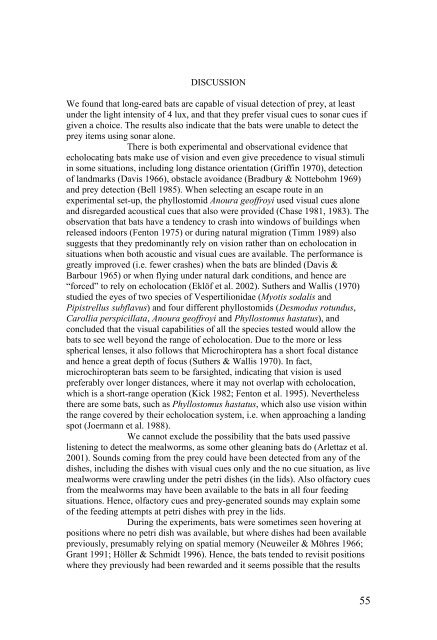Vision in echolocating bats - Fladdermus.net
Vision in echolocating bats - Fladdermus.net
Vision in echolocating bats - Fladdermus.net
Create successful ePaper yourself
Turn your PDF publications into a flip-book with our unique Google optimized e-Paper software.
DISCUSSION<br />
We found that long-eared <strong>bats</strong> are capable of visual detection of prey, at least<br />
under the light <strong>in</strong>tensity of 4 lux, and that they prefer visual cues to sonar cues if<br />
given a choice. The results also <strong>in</strong>dicate that the <strong>bats</strong> were unable to detect the<br />
prey items us<strong>in</strong>g sonar alone.<br />
There is both experimental and observational evidence that<br />
echolocat<strong>in</strong>g <strong>bats</strong> make use of vision and even give precedence to visual stimuli<br />
<strong>in</strong> some situations, <strong>in</strong>clud<strong>in</strong>g long distance orientation (Griff<strong>in</strong> 1970), detection<br />
of landmarks (Davis 1966), obstacle avoidance (Bradbury & Nottebohm 1969)<br />
and prey detection (Bell 1985). When select<strong>in</strong>g an escape route <strong>in</strong> an<br />
experimental set-up, the phyllostomid Anoura geoffroyi used visual cues alone<br />
and disregarded acoustical cues that also were provided (Chase 1981, 1983). The<br />
observation that <strong>bats</strong> have a tendency to crash <strong>in</strong>to w<strong>in</strong>dows of build<strong>in</strong>gs when<br />
released <strong>in</strong>doors (Fenton 1975) or dur<strong>in</strong>g natural migration (Timm 1989) also<br />
suggests that they predom<strong>in</strong>antly rely on vision rather than on echolocation <strong>in</strong><br />
situations when both acoustic and visual cues are available. The performance is<br />
greatly improved (i.e. fewer crashes) when the <strong>bats</strong> are bl<strong>in</strong>ded (Davis &<br />
Barbour 1965) or when fly<strong>in</strong>g under natural dark conditions, and hence are<br />
“forced” to rely on echolocation (Eklöf et al. 2002). Suthers and Wallis (1970)<br />
studied the eyes of two species of Vespertilionidae (Myotis sodalis and<br />
Pipistrellus subflavus) and four different phyllostomids (Desmodus rotundus,<br />
Carollia perspicillata, Anoura geoffroyi and Phyllostomus hastatus), and<br />
concluded that the visual capabilities of all the species tested would allow the<br />
<strong>bats</strong> to see well beyond the range of echolocation. Due to the more or less<br />
spherical lenses, it also follows that Microchiroptera has a short focal distance<br />
and hence a great depth of focus (Suthers & Wallis 1970). In fact,<br />
microchiropteran <strong>bats</strong> seem to be farsighted, <strong>in</strong>dicat<strong>in</strong>g that vision is used<br />
preferably over longer distances, where it may not overlap with echolocation,<br />
which is a short-range operation (Kick 1982; Fenton et al. 1995). Nevertheless<br />
there are some <strong>bats</strong>, such as Phyllostomus hastatus, which also use vision with<strong>in</strong><br />
the range covered by their echolocation system, i.e. when approach<strong>in</strong>g a land<strong>in</strong>g<br />
spot (Joermann et al. 1988).<br />
We cannot exclude the possibility that the <strong>bats</strong> used passive<br />
listen<strong>in</strong>g to detect the mealworms, as some other glean<strong>in</strong>g <strong>bats</strong> do (Arlettaz et al.<br />
2001). Sounds com<strong>in</strong>g from the prey could have been detected from any of the<br />
dishes, <strong>in</strong>clud<strong>in</strong>g the dishes with visual cues only and the no cue situation, as live<br />
mealworms were crawl<strong>in</strong>g under the petri dishes (<strong>in</strong> the lids). Also olfactory cues<br />
from the mealworms may have been available to the <strong>bats</strong> <strong>in</strong> all four feed<strong>in</strong>g<br />
situations. Hence, olfactory cues and prey-generated sounds may expla<strong>in</strong> some<br />
of the feed<strong>in</strong>g attempts at petri dishes with prey <strong>in</strong> the lids.<br />
Dur<strong>in</strong>g the experiments, <strong>bats</strong> were sometimes seen hover<strong>in</strong>g at<br />
positions where no petri dish was available, but where dishes had been available<br />
previously, presumably rely<strong>in</strong>g on spatial memory (Neuweiler & Möhres 1966;<br />
Grant 1991; Höller & Schmidt 1996). Hence, the <strong>bats</strong> tended to revisit positions<br />
where they previously had been rewarded and it seems possible that the results<br />
55


